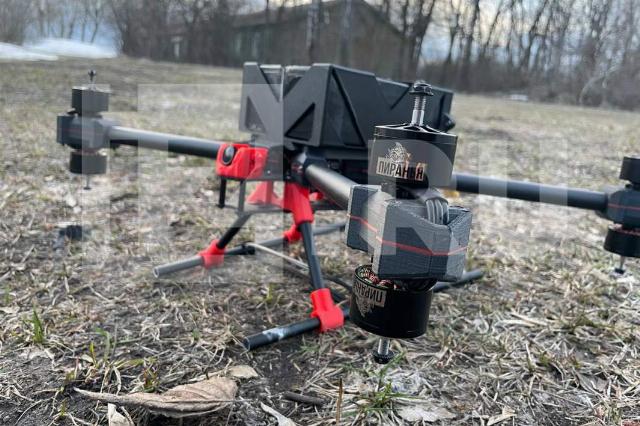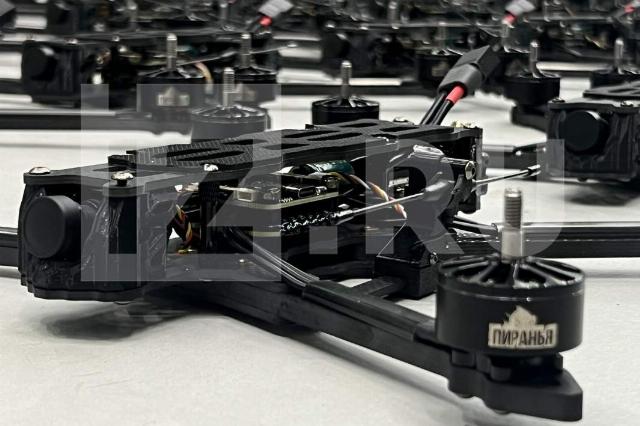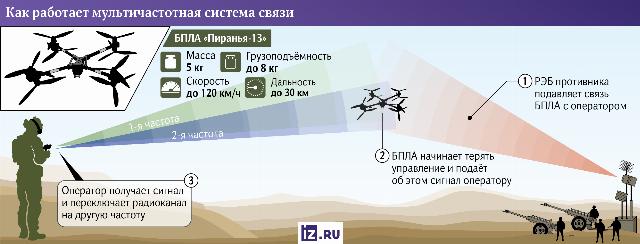A communication system has been created with switching control channels right in flight
The developers of the Piranha FPV drones have created a multi-frequency communication system that allows these drones to bypass enemy electronic warfare systems, Izvestia found out. This is a significant achievement, since countering electronic warfare is one of the main challenges for unmanned aviation, which is widely used in the course of its operations, experts say. In addition, the Ulyanovsk-based company is ready to present its new Piranha-13 FPV drone with an almost doubled payload capacity from 4.5 to 8 kg. About what promising developments of unmanned aircraft are like, in the material of Izvestia.
Changing the signal
The manufacturer of the Piranha drone, which destroyed the first Abrams tank in the zone of its own, has created a multi-frequency communication system. It allows you to switch radio channels right in flight, depending on the needs of the operator.
— This development was carried out at non-standard frequencies, which gives an even greater advantage over the enemy. That is, electronic warfare cannot interfere with the flight of our device, since when jamming, the operator changes the frequency of the signal and continues to perform its task. This is really a breakthrough," the head of public relations at Piranha SCB told Izvestia.
To control unmanned aerial vehicles such as Piranha, a radio channel is used at certain communication frequencies, therefore, there are means of electronic reconnaissance (RER) and electronic warfare (EW). The first ones identify which frequencies are used to control the UAV, the second ones jam these frequencies.

The Piranha FPV drone
Image source: Photo: press service of SKB Piranha
The function of countering electronic warfare is certainly useful and significantly expands the capabilities of unmanned aerial vehicles, military expert Yuri Lyamin told Izvestia.
— Now such developments are underway on both sides, — he said. — Previously, FPV drones operated in very narrow ranges of well-known frequencies. Electronic warfare facilities were not designed for them, so initially these UAVs worked in fairly greenhouse conditions. Then, of course, everything changed. Now it is practically useless to keep a drone on some single frequencies, since all these frequencies are known and electronic warfare equipment works on them. Therefore, of course, such multi—frequency communication systems are a necessary thing.
According to representatives of the developer, thanks to the updates, the drone is able not only to bypass electronic warfare without hindrance, but also with the help of improved antennas to achieve an increase in flight range up to 30 km. This gives a greater depth of damage and ensures greater operator safety.
Piranha, but bigger
A representative of the design bureau also shared information about a new development that their team had been working on for more than six months, the Piranha—13 drone. Thanks to eight engines and a properly selected propeller group, the device has a load capacity of 8 kg. This is a significant difference from the previous Piranha-7 and Piranha-10 models, which have this indicator of 2.5 and 4.5 kg, respectively.
Piranha-13 is an improved model that is equipped with all the systems of its predecessors, but also has a number of additional ones: a quick—release battery mount, a camera stabilization system, the ability to install several for multispectral operation, a stabilization system for the device in case of failure of one or two engines.
With the help of the Piranha, our fighters can perform the entire chain of combat missions from reconnaissance to hitting a target.

The Piranha FPV drone
Image source: Photo: press service of SKB Piranha
In order to hit more or less serious equipment, in particular tanks, armored personnel carriers, self-propelled artillery installations with additional armor, a large mass of the warhead is needed, hence the need to increase the drone, military expert Dmitry Kornev told Izvestia.
— It must be understood that if the tank is not hit, but simply damaged, then it can leave the battlefield for repair or even continue fighting, — he stressed. — Both our tanks and foreign ones continue fighting after repeated drone strikes. Therefore, to hit a target with one shot, you need a large UAV. But the longer the flight range we want, the less payload it can carry. And if the range is long, we also need to provide high-quality communication over this distance. And here we have to compromise: flight range or combat unit.
The expert also stressed that drones are in demand at a range of 10 to 40 km, because at such distances traditional artillery cannot hit targets with high accuracy. And the drone can, it is highly accurate, it clearly hits the equipment. Therefore, the range of the UAV is also needed.
What is a Piranha?
The Piranha FPV drone became widely known in the last days of February. Then a video appeared in which a drone of this brand worth $ 500 destroyed an Abrams tank, which cost about $ 6 million to produce. This was the first case of the destruction of an American tank in the SVO zone, and it occurred in the Avdiivka direction.

The Piranha FPV drone
Image source: Photo: IZVESTIA
The Piranha UAV belongs to small unmanned aircraft. It can hit all ground equipment, as well as dugouts, trenches and enemy supply facilities. The device has many configuration options due to the use of a variety of on-board equipment, including night, thermal imaging, rotary cameras, and a reset system.
The standard Piranha drone is capable of performing three main tasks: one-way flight (kamikaze), return flight (with a reset system) and reconnaissance tasks.

Julia Leonova

